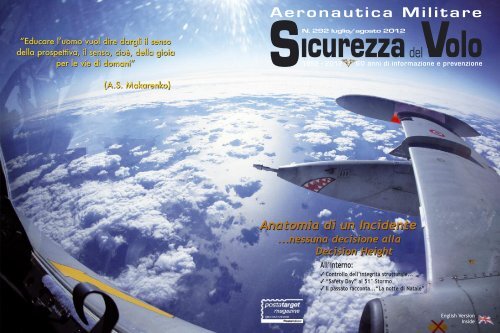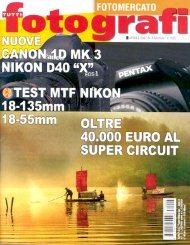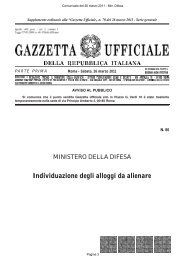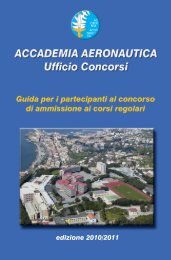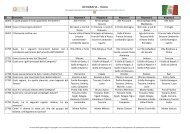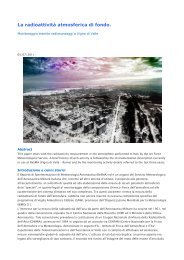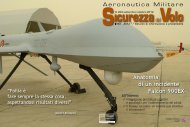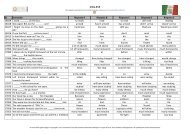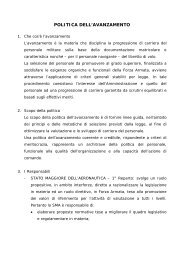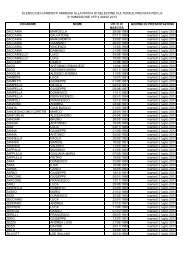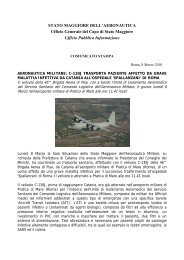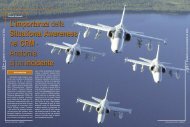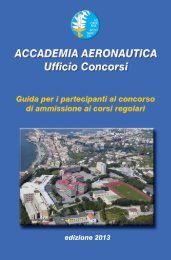Scarica l'intera rivista in formato pdf - Aeronautica Militare Italiana
Scarica l'intera rivista in formato pdf - Aeronautica Militare Italiana
Scarica l'intera rivista in formato pdf - Aeronautica Militare Italiana
You also want an ePaper? Increase the reach of your titles
YUMPU automatically turns print PDFs into web optimized ePapers that Google loves.
“Educare l’uomo vuol dire dargli il senso<br />
della prospettiva, il senso, cioè, della gioia<br />
per le vie di domani”<br />
(A.S. Makarenko)<br />
<strong>Aeronautica</strong> <strong>Militare</strong><br />
SMA NAZ/129/2008<br />
N. 292 luglio/agosto 2012<br />
1952 - 2012 60 anni di <strong>in</strong>formazione e prevenzione<br />
Anatomia di un Incidente<br />
...nessuna decisione alla<br />
Decision Height<br />
All’<strong>in</strong>terno:<br />
3 Controllo dell’<strong>in</strong>tegrità strutturale...<br />
3 “Safety Day” al 51° Stormo<br />
3 Il passato racconta...“La notte di Natale”<br />
English Version<br />
Inside
Sicurezza del Volo<br />
n° 292<br />
luglio/agosto 2012<br />
Anno LX<br />
Periodico Bimestrale<br />
fondato nel 1952 edito da:<br />
<strong>Aeronautica</strong> <strong>Militare</strong><br />
Istituto Superiore per la<br />
Sicurezza del Volo<br />
Viale dell’Università, 4<br />
00185 ROMA<br />
Redazione:<br />
tel. 06 4986 6648 – 06 4986 6659<br />
fax 0649866857<br />
e-mail: <strong>rivista</strong>sv@aeronautica.difesa.it<br />
www.aeronautica.difesa.it/editoria/<strong>rivista</strong>sv<br />
Direttore Editoriale<br />
Gen. B.A. Amedeo Magnani<br />
Direttore Responsabile<br />
T.Col. Anton<strong>in</strong>o Faruoli<br />
Vice Direttore<br />
T.Col. Giuseppe Fauci<br />
Redazione, Grafica e Impag<strong>in</strong>azione<br />
Cap. Miriano Porri<br />
Primo M.llo Alessandro Cuccaro<br />
Serg. Magg. Stefano Bracc<strong>in</strong>i<br />
Anna Emilia Falcone<br />
Tiratura:<br />
n. 7.000 copie<br />
Registrazione:<br />
Tribunale di Roma n. 180 del 27/03/1991<br />
Stampa:<br />
Fotolito Moggio - Roma<br />
Tel. 0774381922<br />
Traduzioni a cura di:<br />
Ten. Jacopo Maria Grassi<br />
Prof. Michele Buonsanti<br />
In copert<strong>in</strong>a:<br />
velivolo FT-339B del 61° Stormo Lecce<br />
(foto del Cap. Cugliari)<br />
Chiuso il 31/08/2012<br />
Foto:<br />
“Troupe Azzurra” e<br />
“Redazione S.V.”<br />
Incidenti e Inconvenienti di Volo<br />
2<br />
22<br />
Rubriche<br />
Anatomia di un <strong>in</strong>cidente:<br />
nessuna decisione... alla Decision Height<br />
Ten. Jacopo Maria Grassi<br />
Lessons Identified<br />
Ufficio Investigazione dell’I.S.V.<br />
Attività di Prevenzione/Investigazione<br />
nel Campo Manutentivo<br />
10<br />
28<br />
32<br />
Controllo dell’<strong>in</strong>tegrità strutturale <strong>in</strong><br />
materiali compositi ad uso aeronautico<br />
Prof. Michele Buonsanti - Prof. Giuseppe Megali<br />
Ben fatto: “Safety Day” al 51° Stormo<br />
Col. Enrico Garett<strong>in</strong>i<br />
Il Passato racconta...”La notte di Natale”<br />
La Redazione
2<br />
Incidenti e Inconvenienti di volo<br />
Anatomia di un <strong>in</strong>cidente<br />
Nessuna decisione ...<br />
alla<br />
Decision Height<br />
Ten. Jacopo Maria Grassi<br />
“No decision at Decision Height” by Mark<br />
Lacagn<strong>in</strong>a (AeroSafety World – Oct.11)<br />
Rivista n° 292/2012<br />
Foto da: www.planetalk<strong>in</strong>glive.com<br />
3
4<br />
Incidenti e Inconvenienti di volo<br />
Le condizioni meteorologiche presso l'aeroporto<br />
di Birm<strong>in</strong>gham (Inghilterra) il pomeriggio del 19<br />
Novembre 2010 vennero def<strong>in</strong>ite, secondo alcuni<br />
testimoni, estremamente atipiche. Un cielo terso,<br />
privo di nubi prevaleva sull'aeroporto e una leggera<br />
brezza da sud tratteneva dei banchi di nebbia visibili<br />
a nord della baia. Poco dopo il vento, cambiando<br />
<strong>in</strong>tensità e direzione, li spostò, trasc<strong>in</strong>andoli sopra<br />
l'aeroporto. Nel frattempo, l'equipaggio di un Cessna<br />
Citation 501 stava effettuando l'avvic<strong>in</strong>amento ILS<br />
(Instrument Land<strong>in</strong>g System) per pista 15.<br />
I bollett<strong>in</strong>i meteo ascoltati dall'equipaggio prima<br />
dell'<strong>in</strong>izio della procedura, facevano presagire condizioni<br />
di volo a vista (VMC) durante tutto il sentiero di<br />
discesa s<strong>in</strong>o alla testata pista, <strong>in</strong> accordo anche con<br />
quanto scritto dalla U.K. Air Accidents Investigation<br />
Branch (AAIB). Tuttavia, il banco di nebbia, muovendosi<br />
nella stessa direzione, <strong>in</strong>ghiottì letteralmente l'aeromobile<br />
mentre questo si avvic<strong>in</strong>ava alla Decision Height<br />
(DH) pubblicata sul PIV.<br />
“Il comandante (pilot monitor<strong>in</strong>g) veniva distratto<br />
dalla repent<strong>in</strong>a e <strong>in</strong>aspettata perdita dei riferimenti<br />
visivi esterni dimenticandosi di effettuare le chiamate<br />
decisive di “Land” o “Go Around” alla DH” così come è<br />
emerso dal report effettuato dalla commissione d'<strong>in</strong>chiesta.<br />
Il co-pilota (pilot fly<strong>in</strong>g) si confuse e il<br />
Citation 501 cont<strong>in</strong>uò la sua discesa s<strong>in</strong>o ad urtare<br />
prima l'antenna del Glide Slope poi il terreno, nella<br />
parte destra della pista.<br />
Il comandante rimase seriamente ferito nell'impatto,<br />
il co-pilota solo lievemente e l'aereo venne<br />
prima danneggiato dall'impatto con l'antenna poi<br />
distrutto da un fuoco a bordo.<br />
“No decision at Decision Height”<br />
Witnesses described the weather conditions at<br />
Birm<strong>in</strong>gham (England) Airport the afternoon of<br />
November 19, 2010, as extremely unusual.<br />
For hours, sunsh<strong>in</strong>e and blue skies prevailed at<br />
the airport, with southerly w<strong>in</strong>ds hold<strong>in</strong>g a fog bank<br />
at bay to the north of the field. When the w<strong>in</strong>ds suddenly<br />
shifted to the north, however, the fog moved<br />
with startl<strong>in</strong>g rapidity over the airport.<br />
Dur<strong>in</strong>g this time, the flight crew of a Cessna<br />
Citation 501 was conduct<strong>in</strong>g the <strong>in</strong>strument land<strong>in</strong>g<br />
system (ILS) approach to Runway 15.<br />
Weather reports and their own observations at<br />
the beg<strong>in</strong>n<strong>in</strong>g of the approach likely had led the<br />
pilots to expect visual conditions all the way to touchdown,<br />
accord<strong>in</strong>g to the report by the U.K. Air<br />
Accidents Investigation Branch (AAIB).<br />
However, the fog bank moved <strong>in</strong> the same direction<br />
and enveloped the light jet as it neared the<br />
published Decision Height (DH).<br />
The commander, the pilot monitor<strong>in</strong>g, likely<br />
became distracted by the sudden and unexpected<br />
loss of visual references, and he neglected to make<br />
the required callout to land or go around when the<br />
aircraft reached DH, the report said.<br />
The copilot, the pilot fly<strong>in</strong>g, became confused,<br />
and the Citation 501 cont<strong>in</strong>ued descend<strong>in</strong>g until it<br />
struck the glideslope antenna and then terra<strong>in</strong> off<br />
the right side of the runway.<br />
The commander was seriously <strong>in</strong>jured, the copilot<br />
susta<strong>in</strong>ed m<strong>in</strong>or <strong>in</strong>juries, and the aircraft was<br />
destroyed by the impact and a fire.<br />
www.aviazionecivile.org<br />
Trasporto Organi<br />
Il Cessna Citation 501 veniva utilizzato da questa<br />
compagnia aerea essenzialmente come trasporto VIP<br />
con base Liverpool. Gli altri due Citation della flotta<br />
erano entrambi mod. 550 II ed erano usati pr<strong>in</strong>cipalmente<br />
come charter. Tuttavia quel giorno il C501,<br />
veniva rischedulato per un volo charter: un trasporto<br />
organi da Belfast, Irlanda del Nord, s<strong>in</strong>o a<br />
Cambridge.<br />
Il comandante, 58 anni, aveva 7.200 ore di volo<br />
di cui 3.000 sulla macch<strong>in</strong>a. Il copilota, la cui età<br />
non venne specificata, aveva 1.785 ore di volo, 735<br />
con quell'aereo.<br />
“Il comandante era esperto sul tipo di macch<strong>in</strong>a<br />
e, <strong>in</strong> particolar modo, sul G-VUEM [il 501 ] con cui<br />
ha volato diverse volte. Il copilota ha volato regolarmente<br />
con questo tipo di aeromobile per molti anni,<br />
ma non così tanto col 501.” L'equipaggio si presentò<br />
all'aeroporto di Liveropool per <strong>in</strong>iziare l’attività di<br />
volo giornaliera alle 08.45 locali, dopodiché una<br />
volta riposizionati presso l'aeroporto di Belfast gli<br />
Rivista n° 292/2012<br />
Organ Transfer<br />
picstop<strong>in</strong>.com<br />
The Citation 501, or I/SP, usually was used by the<br />
Liverpool-based operator for corporate flights. The<br />
other two aircraft <strong>in</strong> its fleet, both Citation 550 II<br />
models, ma<strong>in</strong>ly were used for charter operations.<br />
Nevertheless, the 501 had been pressed <strong>in</strong>to service<br />
for a charter flight, to transport a human transplant<br />
organ from Belfast, Northern Ireland, to<br />
Cambridge. The commander, 58, had 7,200 flight<br />
hours, <strong>in</strong>clud<strong>in</strong>g 3,000 hours <strong>in</strong> type. The copilot,<br />
whose age was not specified, had 1,785 flight hours,<br />
<strong>in</strong>clud<strong>in</strong>g 735 hours <strong>in</strong> type.<br />
“The commander was experienced on the aircraft<br />
type and had flown G-VUEM [the 501] on a number<br />
of previous occasions,” the report said. “The copilot<br />
had been fly<strong>in</strong>g the aircraft type with the operator<br />
regularly for several years but had not flown G-VUEM<br />
as frequently as their other two aircraft.”<br />
The pilots reported for duty at Liverpool Airport<br />
at 0845 local time. After position<strong>in</strong>g the aircraft to<br />
Belfast City Airport, they found that the charter fli-<br />
5
6<br />
Incidenti e Inconvenienti di volo<br />
venne comunicato che il trasporto per Cambridge<br />
era stato cancellato. Una volta là, casualmente, gli<br />
veniva comunicato e così assegnato, un nuovo volo<br />
di trasporto organi dall'aeroporto Aldergrove di<br />
Belfast per Birm<strong>in</strong>gham.<br />
Decollati alle 14.50 alla volta di Birm<strong>in</strong>gham, ricevettero<br />
le condizioni meteorologiche <strong>in</strong> vigore, che<br />
erano ottimali per condurre un avvic<strong>in</strong>amento a vista.<br />
Il controllo radar aveva fornito dei vettori per aiutare<br />
l'aeromobile a stabilizzarsi lungo il sentiero f<strong>in</strong>ale<br />
dell'ILS. “Durante l'avvic<strong>in</strong>amento, il comandante<br />
<strong>in</strong>dividuò l'aeroporto da molto lontano. Così le circostanze<br />
erano tali che l'equipaggio si aspettava di concludere<br />
l'avvic<strong>in</strong>amento <strong>in</strong> condizioni di volo a vista.”<br />
Ritardo sulla <strong>in</strong>tercettazione del LOC<br />
Come detto poc'anzi, il co-pilota aveva una limitata<br />
esperienza sul 501. “Ci sono molte differenze tra il<br />
G-VUEM e gli altri due modelli, <strong>in</strong>clusa la strumentazione,<br />
l’equipaggiamento e le prestazioni dell'aeromobile.”<br />
Questo è ciò che si ev<strong>in</strong>ce dal rapporto.<br />
Il co-pilota, seduto a destra, selezionava la modalità<br />
di Approach dell'autopilota. Gli strumenti di volo<br />
nella sua parte del cockpit però non prevedevano un<br />
flight director.<br />
[...] “altri piloti che hanno volato con questo<br />
(Antenna Glideslope colpita dal Cessna Citation 501)<br />
ght to Cambridge no longer was necessary.<br />
Apparently by chance, however, transport of another<br />
transplant organ was required from Belfast<br />
Aldergrove Airport to Birm<strong>in</strong>gham, and the crew was<br />
reassigned to make that flight.<br />
The Citation departed from Belfast Aldergrove<br />
at 14.50 and received the forecasts for Birm<strong>in</strong>gham,<br />
that were adequate for a visual approach.<br />
A radar controller provided vectors to help the<br />
crew establish the aircraft on the ILS approach.<br />
“On the approach, the commander sighted the<br />
airfield from some distance,” the report said.<br />
“Thus, the circumstances were such that the<br />
crew could reasonably have expected to complete<br />
the approach <strong>in</strong> visual conditions.”<br />
Late Intercept<br />
As mentioned, the copilot had limited experience <strong>in</strong><br />
the 501. “There were a number of differences between<br />
G-VUEM and the other two aircraft, <strong>in</strong>clud<strong>in</strong>g the <strong>in</strong>struments,<br />
operation of cockpit displays and equipment,<br />
eng<strong>in</strong>e management and aircraft performance,” the<br />
report said. The copilot, who was <strong>in</strong> the right seat, had<br />
selected the autopilot’s approach mode. The flight<br />
<strong>in</strong>struments on his panel did not <strong>in</strong>clude a flight director.<br />
[...] “other pilots who had flown this aircraft advised<br />
the AAIB that to <strong>in</strong>tercept and track a localizer course<br />
successfully with the autopilot engaged, the speed<br />
would need to be reduced to around 180 kt.” The pilots<br />
had calculated an approach speed of 104 kt, but recorded<br />
air traffic control (ATC) radar data showed that the<br />
Citation’s groundspeed was 254 kt as it neared the 149<br />
degree localizer course on a head<strong>in</strong>g of 135 degrees, the<br />
f<strong>in</strong>al vector assigned by the radar controller.<br />
Apparently because of the high speed, the aircraft<br />
crossed the localizer centerl<strong>in</strong>e three times while the<br />
RVR <strong>in</strong> the touchdown zone (TDZ) was cont<strong>in</strong>ously<br />
decreas<strong>in</strong>g. The commander made the standard callouts<br />
at 500 ft and 100 ft above DH, but neither pilot<br />
remembered a callout at DH, when, with the autopilot<br />
disengaged, the aircraft deviated slightly to the<br />
right. About 30 seconds later the left w<strong>in</strong>g struck the<br />
top of the glideslope antenna.<br />
No Perception of Time<br />
The report said that <strong>in</strong> the last three m<strong>in</strong>utes of<br />
the Citation’s approach, touchdown RVR had decreased<br />
from 1,100 m to 300 m (1,000 ft). The fog bank<br />
had not yet reached the midpo<strong>in</strong>t and the end of the<br />
runway, where the RVRs rema<strong>in</strong>ed at 1,500 m.<br />
A pilot of an aircraft that preceded the Citation on<br />
the ILS approach told <strong>in</strong>vestigators that his aircraft had<br />
velivolo, segnalarono alla AAIB che per <strong>in</strong>tercettare<br />
e poi volare una course LOC con l'autopilota <strong>in</strong>gaggiato,<br />
la velocità dovrebbe essere <strong>in</strong>torno ai 180 kt”.<br />
I piloti calcolarono una velocità di avvic<strong>in</strong>amento<br />
<strong>in</strong>torno ai 104 kt, ma le registrazioni degli enti CTA<br />
hanno dimostrato che la groundspeed del Citation<br />
era di 254 kt mentre si avvic<strong>in</strong>ò alla course f<strong>in</strong>ale di<br />
149° del localizer con vettore f<strong>in</strong>ale di 135°, istruito<br />
dal controllo radar.<br />
Apparentemente a causa dell’elevata velocità, il<br />
velivolo attraversò per tre volte la l<strong>in</strong>ea di centro<br />
pista del localizer mentre la RVR alla touchdown<br />
zone cont<strong>in</strong>uava a dim<strong>in</strong>uire costantemente.<br />
Il comandante effettuò le chiamate standard a<br />
500 ft e a 100 ft sopra la DH, ma nessuno dei piloti<br />
si ricordò della chiamata alla DH, quando, con l’autopilota<br />
dis<strong>in</strong>serito, l’aeromobile <strong>in</strong>iziò a deviare<br />
leggermente verso destra. Circa 30 secondi più tardi<br />
l’ala s<strong>in</strong>istra colpiva la parte superiore dell’antenna<br />
Glideslope.<br />
fonte: stock.xchng<br />
Rivista n° 292/2012<br />
entered but quickly exited the fog bank as it neared<br />
DH. A pilot <strong>in</strong> another aircraft ahead of the Citation<br />
said that his aircraft appeared to be “surf<strong>in</strong>g” down<br />
the slop<strong>in</strong>g face of the fog bank on f<strong>in</strong>al approach.<br />
Recorded ATC radar data showed that the<br />
Citation’s flight path had not changed when it descended<br />
below a height of 300 ft, which <strong>in</strong>dicated that the<br />
copilot had made no control <strong>in</strong>puts after the commander<br />
called “100 above” DH.<br />
The copilot told <strong>in</strong>vestigators that shortly after<br />
hear<strong>in</strong>g that callout, he asked the commander if he<br />
should go around. “He recalled hear<strong>in</strong>g the commander<br />
say, ‘No, go left,’” the report said. “He then caught<br />
a glimpse of the antenna ahead, too late to<br />
attempt to avoid it.”<br />
The commander did not recall hav<strong>in</strong>g given any<br />
<strong>in</strong>structions to the copilot after the “100 above” callout.<br />
The report said that the aircraft likely entered<br />
the fog bank at this po<strong>in</strong>t, and the capta<strong>in</strong> lost all<br />
external visual references.<br />
7
8<br />
Incidenti e Inconvenienti di volo<br />
Nessuna percezione temporale<br />
Negli ultimi tre m<strong>in</strong>uti dell'avvic<strong>in</strong>amento,<br />
la RVR passò da 1100 m a 300 m (1000 ft). Il<br />
banco di nebbia non raggiunse il punto <strong>in</strong>termedio<br />
della pista, facendo così rimanere alta<br />
la RVR, 1500 m ca.<br />
Un pilota di un aereo che aveva preceduto<br />
il Citation nell'avvic<strong>in</strong>amento ILS, ha sottol<strong>in</strong>eato<br />
com'era prima entrato poi rapidamente<br />
uscito dal banco di nebbia, <strong>in</strong> prossimità della<br />
DH. Un altro, <strong>in</strong>vece, sempre davanti al<br />
Citation, aveva descritto la scena con: “il mio<br />
aereo sembrava facesse surf sotto il banco di<br />
nebbia che sopravanzava, nel tratto f<strong>in</strong>ale<br />
della procedura.”<br />
I dati registrati dall'ente di controllo hanno<br />
evidenziato come il sentiero di discesa del<br />
Citation non venne cambiato quando si scese<br />
al di sotto dei 300 ft: il copilota non fece alcuna<br />
correzione necessaria dopo la chiamata<br />
“100 ft sopra la m<strong>in</strong>ima”.<br />
Il copilota affermò che poco dopo aver sentito<br />
quella chiamata, chiese al comandante se<br />
avesse dovuto riattaccare. Sentì nuovamente<br />
una chiamata da parte sua: “No, vira a s<strong>in</strong>istra.”<br />
Così si ev<strong>in</strong>ce dal rapporto. “E <strong>in</strong>travide<br />
l'antenna d<strong>in</strong>anzi l'aeromobile: fu però troppo<br />
tardi per tentare di evitarla.”<br />
Il comandante non ricordava affatto di aver<br />
dato alcun tipo di istruzione al co-pilota dopo<br />
la chiamata “100 ft sopra la m<strong>in</strong>ima”.<br />
L’<strong>in</strong>gresso dell'aeromobile nel banco di nebbia<br />
fece perdere completamente al comandante<br />
tutti i riferimenti visivi esterni. Agli <strong>in</strong>vestigatori<br />
disse che <strong>in</strong>tercorsero solamente alcuni<br />
secondi dalla chiamata “100 ft sopra” all'impatto<br />
con l'antenna.<br />
[...] mentre <strong>in</strong>vece furono circa ventic<strong>in</strong>que.<br />
Conclusioni e raccomandazioni<br />
“L'attesa dell'equipaggio di completare l'approccio<br />
<strong>in</strong> VMC e l'<strong>in</strong>contro <strong>in</strong>aspettato con la nebbia nel<br />
segmento f<strong>in</strong>ale dell'avvic<strong>in</strong>amento ha causato un<br />
crollo nel coord<strong>in</strong>amento dell'equipaggio.<br />
Nel momento <strong>in</strong> cui un aeromobile si avvic<strong>in</strong>a alla<br />
testata pista TDZ -touchdown zone-, le <strong>in</strong>dicazioni di<br />
localizer e glideslope diventano estremamente sensibili,<br />
di conseguenza qualsiasi correzione può <strong>in</strong>generarne<br />
<strong>in</strong>avvertitamente una opposta e di maggiore<br />
<strong>in</strong>tensità”*.<br />
Il compito del pilot fly<strong>in</strong>g diventa più esigente e<br />
il ruolo del pilot monitor<strong>in</strong>g acquista così più signi-<br />
The commander told <strong>in</strong>vestigators he had perceived<br />
that only a few seconds had passed between his<br />
“100 above” call and the collision with the glideslope<br />
antenna.<br />
[...] In fact, the elapsed time would have been<br />
around 25 seconds.”<br />
Conclusions and recommendations<br />
The report said that the crew’s expectation of<br />
complet<strong>in</strong>g the approach <strong>in</strong> visual conditions and<br />
the unexpected encounter with the fog late <strong>in</strong> the<br />
approach caused a breakdown <strong>in</strong> crew coord<strong>in</strong>ation.<br />
“As an aircraft gets closer to a runway, the localizer<br />
and glideslope <strong>in</strong>dications become <strong>in</strong>creas<strong>in</strong>gly<br />
sensitive, and small corrections have a relatively<br />
large effect,”* the report said.<br />
“The task for the fly<strong>in</strong>g pilot becomes more<br />
ficato. Un volo concluso <strong>in</strong> sicurezza si basa su un<br />
CRM efficace e con procedure operative (SOP) chiare.<br />
La discont<strong>in</strong>uità del monitoraggio sulla corretta<br />
esecuzione della procedura strumentale, la mancata<br />
chiamata alla m<strong>in</strong>ima [callout at DH] ha portato alla<br />
discesa del velivolo al di sotto della stessa con le<br />
conseguenze che sappiamo.<br />
Il rapporto f<strong>in</strong>ale evidenziò che l’operatore rivisitò<br />
le proprie procedure operative, richiedendo, <strong>in</strong><br />
particolare, che tutti gli avvic<strong>in</strong>amenti strumentali<br />
venissero condotti con l’autopilota e/o il flight<br />
director <strong>in</strong>seriti.<br />
* Pilot-Induced Oscillations (def<strong>in</strong>izione della MIL-HDBK-<br />
1797A, USAF):<br />
“oscillazioni sostenute e/o <strong>in</strong>controllabili derivanti dagli<br />
sforzi del pilota a comandare l'aeromobile; si verificano<br />
quando il pilota comanda <strong>in</strong>avvertitamente una serie sempre<br />
più crescente di correzioni, ogni reazione del velivolo<br />
all'impulso precedente viene contrastata con una ipercorrezione<br />
nella direzione opposta.”<br />
Rivista n° 292/2012<br />
demand<strong>in</strong>g, and the role of the monitor<strong>in</strong>g pilot has<br />
greater significance.<br />
“A successful outcome relies on effective crew<br />
coord<strong>in</strong>ation, based on clear SOPs. The monitor<strong>in</strong>g<br />
of the approach broke down <strong>in</strong> the latter stages, and<br />
the crucial [callout at DH] was missed, which led to<br />
the aircraft’s descent below m<strong>in</strong>imums.”<br />
The report said that the aircraft operator<br />
reviewed its SOPs after the accident and issued a<br />
crew notice requir<strong>in</strong>g, <strong>in</strong> part, that all <strong>in</strong>strument<br />
approaches be conducted with the autopilot and/or<br />
the flight director engaged.<br />
*Pilot-<strong>in</strong>duced oscillations, as def<strong>in</strong>ed by MIL-HDBK-1797A,<br />
USAF):<br />
“susta<strong>in</strong>ed or uncontrollable oscillations result<strong>in</strong>g from<br />
efforts of the pilot to control the aircraft and occurs when the<br />
pilot of an aircraft <strong>in</strong>advertently commands an often <strong>in</strong>creas<strong>in</strong>g<br />
series of corrections <strong>in</strong> opposite directions, each an<br />
attempt to cover the aircraft's reaction to the previous <strong>in</strong>put<br />
with an overcorrection <strong>in</strong> the opposite direction.”<br />
9
10<br />
Attività di Prevenzione/Investigazione nel campo manutentivo<br />
Prof. Michele Buonsanti<br />
Prof. Giuseppe Megali<br />
Controllo<br />
dell’<strong>in</strong>tegrità<br />
strutturale<br />
<strong>in</strong> materiali<br />
compositi ad<br />
uso aeronautico<br />
Rivista n° 292/2012<br />
Le tecniche di controllo e valutazione<br />
del tipo non distruttivo (NDT&E - Non<br />
Destructive Test<strong>in</strong>g and Evaluation)<br />
rivestono un ruolo sempre più<br />
importante nell’ispezione dei materiali<br />
compositi, soprattutto per la loro<br />
caratteristica di riuscire a fornire<br />
risultati <strong>in</strong> tempi rapidi e offrendo<br />
soluzioni a basso costo. In questo<br />
contributo si illustrano delle applicazioni<br />
di metodologie NDT&E per l’analisi di<br />
materiali compositi <strong>in</strong> CFRP (Carbon<br />
Fiber Re<strong>in</strong>forced Polymers), materiali<br />
ampiamente <strong>in</strong> uso <strong>in</strong> una ampia varietà<br />
di applicazioni aeronautiche.<br />
11
12<br />
Attività di Prevenzione/Investigazione nel campo manutentivo<br />
“Spesso nuovi materiali stanno <strong>in</strong> attesa per volere dell’artista”<br />
(Lucius Anneaus Seneca 4-65 a.c.)<br />
INTRODUZIONE<br />
L’apprezzata lettura di due lavori del Cap.<br />
Allegrucci [1, 3], parimenti al contributo del Magg.<br />
De Paolis [2], ha fortemente stimolato gli scriventi<br />
ad offrire un contributo di ricerca tipicamente accademico,<br />
ma suffragato da sperimentazione su uno<br />
specifico ambito, a nostro avviso, molto utile all’accrescimento<br />
di quel background che ogni pilota e/o<br />
tecnico manutentore porta come suo <strong>in</strong>dispensabile<br />
bagaglio di conoscenza. In particolare, volando uno<br />
degli autori <strong>in</strong> qualità di PIC da oltre 30 anni su velivoli<br />
leggeri, è risultato possibile riscontrare come<br />
l’evoluzione dei materiali e delle tecnologie abbia<br />
<strong>in</strong>ciso fortemente sia sugli aspetti aerod<strong>in</strong>amici sia<br />
su quelli della manutenzione. Negli anni ’70-‘80 la<br />
struttura resistente era fortemente tradizionale, con<br />
elementi reticolari spaziali <strong>in</strong> lega metallica e rivestimento<br />
<strong>in</strong> materiali similari, qu<strong>in</strong>di velivoli il cui<br />
peso proprio risultava molto consistente. Nel tempo<br />
le strutture portanti hanno mantenuto la loro essenza<br />
costruttiva ma molti degli elementi secondari del<br />
velivolo hanno <strong>in</strong>iziato ad essere sostituiti da materiali<br />
compositi il cui pregio, <strong>in</strong> term<strong>in</strong>i di leggerezza,<br />
<strong>in</strong>cide fortemente sulla prestazione di velivoli, spes-<br />
3 Figura 1<br />
I<br />
STRUCTURAL INTEGRITY CONTROL IN COMPOSITE<br />
MATERIALS FOR AERONAUTICS APPLICATIONS<br />
INTRODUCTION<br />
The appreciated read<strong>in</strong>g of two works of Capt.<br />
Allegrucci [1, 3], also the contribution of Maj. De<br />
Paolis [2], has greatly stimulated the writers to<br />
make a research contribution typically academic,<br />
but supported by experiments on a specific field, <strong>in</strong><br />
our op<strong>in</strong>ion, very useful to enhanc<strong>in</strong>g of that background<br />
that each pilot and/or ma<strong>in</strong>tenance technician<br />
takes as its essential store of knowledge.<br />
In particular, Fly<strong>in</strong>g one of the authors as a<br />
P.C., for over 30 years of light aircraft, it was<br />
noted as the evolution of materials and technologies<br />
have a strong impact on both the aerodynamic<br />
and on those aspects of ma<strong>in</strong>tenance. In the ’70s-<br />
‘80s the traditional structure was highly resistant,<br />
with reticular spatial elements <strong>in</strong> metal alloy and<br />
coat<strong>in</strong>g <strong>in</strong> similar materials, then airplanes where<br />
weight was very consistent.<br />
Over time, the structures have reta<strong>in</strong>ed their<br />
constructive essence but many of the secondary<br />
elements of the aircraft began to be replaced by<br />
composite materials whose value, <strong>in</strong> terms of<br />
lightness, greatly affects the performance of aircraft,<br />
often with only a sufficient driv<strong>in</strong>g force to<br />
- Perdita dell’<strong>in</strong>tegrità strutturale con mantenimento dell’equilibrio aerod<strong>in</strong>amico. (B52H 61023 10.01.1964) fonte USAF;<br />
{ - Loss of structural <strong>in</strong>tegrity ma<strong>in</strong>ta<strong>in</strong><strong>in</strong>g aerodynamical equilibrium. (B52H 61023 10.01.1964) source USAF;<br />
so dotati solo di una sp<strong>in</strong>ta propulsiva sufficiente<br />
alle normali operazioni tipiche dell’aviazione generale.<br />
Se il vantaggio aerod<strong>in</strong>amico è immediatamente<br />
<strong>in</strong>tuibile e riscontrabile, anche gli aspetti manutentivi<br />
ne ricavano positività, attesa la dim<strong>in</strong>uzione<br />
di alcune problematiche tipiche delle strutture<br />
metalliche (es. corrosione).<br />
La progettazione aeronautica si è fortemente, e<br />
giustamente, impossessata dell’uso dei materiali<br />
compositi arrivando, all’<strong>in</strong>izio del terzo millennio, a<br />
realizzare velivoli, <strong>in</strong> particolare per l’A.G., totalmente<br />
<strong>in</strong> materiale composito. Ai vantaggi di un a/m<br />
il cui peso a vuoto risulta relativamente basso, oltre<br />
a garantire adeguata resistenza strutturale, si contrappone<br />
l’esigenza di un controllo di una <strong>in</strong>tegrità<br />
strutturale basata su procedure metodologiche le cui<br />
risultanze sono, necessariamente, affidabili.<br />
L’<strong>in</strong>troduzione delle carbon-res<strong>in</strong>e, all’<strong>in</strong>izio degli<br />
anni ’80, ha segnato l’<strong>in</strong>izio di una nuova era tecnologica<br />
nel già <strong>in</strong>novativo sviluppo dei materiali compositi.<br />
Caratterizzati dall’unione s<strong>in</strong>ergica di due o<br />
più componenti, uno più rigido quale il r<strong>in</strong>forzo (carbonio,<br />
vetro, kevlar), ed uno più tenace, quale la<br />
matrice <strong>in</strong> res<strong>in</strong>a termo<strong>in</strong>durente (epossidica, fenolica,<br />
poliammidica), questi materiali compositi accen-<br />
Rivista n° 292/2012<br />
normal operations typical of general aviation. If<br />
the aerodynamic advantage is easy to understand<br />
and be seen, even the positive aspects of ma<strong>in</strong>tenance<br />
deducted from them, given the decl<strong>in</strong>e of<br />
some typical problems of metal structures (e.g.<br />
corrosion).<br />
The aircraft design is strongly, and rightly, seized<br />
the use of composite materials arriv<strong>in</strong>g at the beg<strong>in</strong>n<strong>in</strong>g<br />
of the third millennium, to build aircraft, <strong>in</strong><br />
particular for the A.G. totally made of composite<br />
material. The advantages of an a/m which the<br />
empty weight is relatively low, <strong>in</strong> addition to ensur<strong>in</strong>g<br />
adequate structural strength, contrasts with the<br />
need for a control of the structural <strong>in</strong>tegrity based<br />
on the results of which are methodological procedures,<br />
necessarily, reliable. The <strong>in</strong>troduction of carbon-res<strong>in</strong>s,<br />
<strong>in</strong> the early '80s, marked the beg<strong>in</strong>n<strong>in</strong>g<br />
of a new technological era <strong>in</strong> the already <strong>in</strong>novative<br />
development of composite materials.<br />
Characterized by the union of two or more<br />
synergistic components, a more rigid which the<br />
re<strong>in</strong>forcement (carbon, glass, kevlar), and a more<br />
tenacious, which the matrix of thermosett<strong>in</strong>g res<strong>in</strong><br />
(epoxy, phenolic, polyimide), these composite<br />
materials accentuate some fundamental structural<br />
- Meccanismi di propagazione di microfratture con effetti catastrofici <strong>in</strong> a/m tipo Comet (fonte NLR-TP 2002-521);<br />
3 Figura 2<br />
{ - Mechanisms of propagation of micro-cracks with catastrophic effects <strong>in</strong> the a/m Comet (by NLR-TP 2002-521);<br />
13
14<br />
Attività di Prevenzione/Investigazione nel campo manutentivo<br />
tuano alcune fondamentali proprietà strutturali:<br />
1. La resistenza e rigidezza delle strutture sono ottimizzabili<br />
attraverso un’opportuna orientazione<br />
delle fibre degli strati successivi del lam<strong>in</strong>ato;<br />
2. La tenacità del materiale può essere opportunamente<br />
migliorata con la più adatta scelta della composizione<br />
della matrice.<br />
Usati per applicazioni aeronautiche di criticità crescente,<br />
hanno visto<br />
gradualmente<br />
il diffondersi<br />
nelle realizzazioni di<br />
vari componenti quali:<br />
flap, slat, spoilers, alettoni,<br />
rudder, elevatori, s<strong>in</strong>o alla<br />
struttura alare ed <strong>in</strong><br />
ultimo alla<br />
fusoliera, specie<br />
quest’ultima<br />
nella nuova generazione<br />
di velivoli leggeri per l’aviazione generale.<br />
Dal punto di vista del comportamento meccanico i<br />
materiali compositi a matrice polimerica comportano<br />
una forte <strong>in</strong>tegrabilità delle strutture con sostanziale<br />
riduzione del numero delle parti componenti, <strong>in</strong>oltre<br />
manifestano:<br />
• eccellente comportamento a fatica;<br />
• sostanziale miglioramento della tolleranza al danno;<br />
• controllo dell’Infiammabilità, dell’emissione di fumi<br />
e della tossicità;<br />
• stabilità e durabilità ambientale;<br />
• ridotti costi di manutenzione/ridotti costi del ciclo<br />
di vita;<br />
• ridotti consumi di carburante derivanti dalle possibili<br />
riduzioni di peso rispetto alle strutture convenzionali.<br />
Le tecniche di controllo e valutazione del tipo non<br />
distruttivo (NDT&E) rivestono un ruolo sempre più<br />
importante nell’ispezione dei materiali compositi,<br />
soprattutto per la loro caratteristica di riuscire a fornire<br />
risultati <strong>in</strong> tempi rapidi e offrendo soluzioni a<br />
basso costo. Al f<strong>in</strong>e di migliorare qualità di produzione<br />
e garantire la sicurezza di un sistema, i dispositivi,<br />
i componenti e le strutture che lo compongono, sono<br />
ispezionati per rilevare la presenza di difettosità (sia<br />
essa di produzione che <strong>in</strong> fase di esercizio) che possa<br />
pregiudicarne la loro <strong>in</strong>tegrità e conseguentemente la<br />
loro utilità futura.<br />
In questo contributo si illustrano delle applicazioni<br />
di metodologie NDT&E (Non Destructive Test<strong>in</strong>g and<br />
Evaluation) per l’analisi di materiali compositi <strong>in</strong><br />
CFRP (Carbon Fiber Re<strong>in</strong>forced Polymers), materiali<br />
ampiamente <strong>in</strong> uso <strong>in</strong> una ampia varietà di applicazioni<br />
aeronautiche.<br />
properties, <strong>in</strong>clud<strong>in</strong>g:<br />
1. The strength and stiffness of the structures can be<br />
optimized through proper orientation of the fibers<br />
of successive layers of the lam<strong>in</strong>ate;<br />
2. The toughness of the material can be suitably<br />
improved by the most suitable choice of composition<br />
of the matrix.<br />
Used for critical aerospace applications <strong>in</strong>creas<strong>in</strong>gly<br />
are seen gradually spread <strong>in</strong> the achievements of<br />
various components such<br />
as flaps, slats, spoilers,<br />
ailerons, rudder, elevators, until the w<strong>in</strong>g structure<br />
and ultimately to the fuselage, especially <strong>in</strong> this<br />
new generation of light aircraft for general aviation.<br />
From the mechanical po<strong>in</strong>t of view the polymer<br />
matrix composite materials have a strong <strong>in</strong>tegration<br />
of the structures with substantial reduction <strong>in</strong> the<br />
number of component parts, also occur:<br />
• excellent fatigue behavior;<br />
• substantially improved damage tolerance;<br />
• <strong>in</strong>flammability, smoke and toxicity control;<br />
• environmental stability and durability;<br />
• reduced ma<strong>in</strong>tenance costs/reduced life cycle<br />
costs;<br />
• reduced fuel consumption result<strong>in</strong>g from possible<br />
reductions <strong>in</strong> weight compared to conventional<br />
structures.<br />
Non Destructive Test<strong>in</strong>g and Evaluation (NDT&E)<br />
play an <strong>in</strong>creas<strong>in</strong>gly important role <strong>in</strong> the <strong>in</strong>spection<br />
of composite materials, primarily for their characteristic<br />
of be<strong>in</strong>g able to deliver rapid results and offer<strong>in</strong>g<br />
low cost solutions.<br />
In order to improve production quality and ensure<br />
the security of a system, devices, components and<br />
structures that comprise it, are <strong>in</strong>spected for the<br />
presence of defects (be it that <strong>in</strong> the production<br />
phase of operation) that may be adversely affected<br />
their <strong>in</strong>tegrity and thus their future usefulness.<br />
In this paper we illustrate the application of NDT<br />
&E methods (Non Destructive Test<strong>in</strong>g and Evaluation)<br />
for the analysis of composite CFRP (Carbon Fiber<br />
Re<strong>in</strong>forced Polymers), materials widely used <strong>in</strong> a<br />
wide variety of aerospace applications.<br />
MECCANICA DEI MATERIALI COMPOSITI - CFRP<br />
Le fibre di carbonio abitualmente utilizzate si<br />
presentano <strong>in</strong> due tipiche offerte, ovvero fibre ad<br />
alta resistenza (o basso modulo elastico) 230 Gpa, e<br />
fibre a bassa resistenza (alto modulo elastico) 480-<br />
700 Gpa anche se il modulo elastico teorico di una<br />
fibra è di circa 1000 Gpa [4].<br />
Il carbonio ha un difetto comune delle sostanze<br />
centrali della tavola periodica ovvero la fragilità.<br />
Sono sufficienti microscopici <strong>in</strong>tagli o difetti molecolari<br />
per <strong>in</strong>nescare rotture catastrofiche.<br />
La formazione <strong>in</strong> fibre riduce questo aspetto ma<br />
la miscelazione con la matrice plastica comporta<br />
comunque trasmissione di sforzi e concentrazioni di<br />
tensioni. Il diagramma sforzo deformazione nella<br />
direzione delle fibre [5] è spiccatamente l<strong>in</strong>eare non<br />
presentando vaste zone di snervamento, come è<br />
tipico dei materiali metallici.<br />
Tutto ciò comporta che la rottura delle lam<strong>in</strong>e<br />
avviene <strong>in</strong> modo fragile, qu<strong>in</strong>di improvviso con avanzamento<br />
progressivo catastrofico, senza trascurare<br />
gli effetti di scala [6].<br />
Rivista n° 292/2012<br />
- Transizione duttile - fragile ed effetto di scala [5];<br />
3 Figura 3<br />
{ - Ductile transition – brittle and scale effect [5];<br />
MECHANICS OF COMPOSITE MATERIALS - CFRP<br />
The carbon fibers usually used are presented <strong>in</strong><br />
two typical deals or high strength fibers (or low<br />
modulus of elasticity) 230 GPa, and fibers with low<br />
resistance (high elastic modulus) 480-700 GPa even<br />
if the elastic modulus of a theoretical fiber is of<br />
about 1000 GPa [4].<br />
Carbon has a common defect of the central substance<br />
of the periodic table or fragility. Microscopic<br />
grooves are sufficient to trigger molecular defects or<br />
catastrophic failure.<br />
The formation <strong>in</strong> fibers reduces this aspect but<br />
the mix<strong>in</strong>g with the plastic matrix, however,<br />
<strong>in</strong>volves transmission of effort and stress concentrations.<br />
The diagram effort deformation <strong>in</strong> the direction<br />
of the fibers [5] is dist<strong>in</strong>ctly non-l<strong>in</strong>ear present<strong>in</strong>g<br />
large areas of yield strength, as is typical of metallic<br />
materials.<br />
All this implies that the break<strong>in</strong>g of the plates is<br />
so fragile, so suddenly with catastrophic <strong>in</strong>ch<strong>in</strong>g,<br />
without neglect<strong>in</strong>g the effects of scale [6].<br />
15
16<br />
Attività di Prevenzione/Investigazione nel campo manutentivo<br />
CARATTERIZZAZIONE DEI DIFETTI IN CFRP<br />
Sulla base di quanto già precedentemente anticipato,<br />
<strong>in</strong> ambito aeronautico, grande importanza è<br />
attribuita al controllo dei materiali impiegati nella<br />
realizzazione dei sistemi f<strong>in</strong>ali nel loro complesso.<br />
Nell’ottica di fornire un adeguato trade-off tra<br />
velocità di ispezione, affidabilità e accuratezza<br />
del controllo, costi, le tecniche di ispezione rappresentano<br />
un nodo cruciale nella valutazione dell’<strong>in</strong>tegrità.<br />
Considerando poi il notevole impiego<br />
dei mezzi aerei, è facile comprendere come sollecitazioni<br />
meccaniche e agenti atmosferici, siano<br />
tra le cause di degrado delle strutture. In tale ottica,<br />
l’impiego di cont<strong>in</strong>ui controlli durante il ciclo<br />
di vita delle strutture, degli impianti, riporta a<br />
quanto precedente puntualizzato <strong>in</strong> term<strong>in</strong>i di<br />
<strong>in</strong>novazione.<br />
Tenuto conto dei fattori di degrado <strong>in</strong> fase di<br />
esercizio, particolare attenzione deve essere qu<strong>in</strong>di<br />
data <strong>in</strong> fase di produzione, al f<strong>in</strong>e di evitare di<br />
<strong>in</strong>trodurre altri fattori di rischio nello stato di vita<br />
del componente.<br />
In particolare, nell’ambito della produzione dei<br />
CFRPs [7-9], le difettosità <strong>in</strong> grado di alterare le<br />
proprietà chimico/fisiche del materiale, mettendo a<br />
rischio l’<strong>in</strong>tegrità del velivolo, risultano essere le<br />
seguenti:<br />
• delam<strong>in</strong>azione: separazione delle lam<strong>in</strong>e che si<br />
riscontra nelle prossimità<br />
dei bordi liberi dei pezzi,<br />
dove sono presenti elevati<br />
picchi di tensione, per la<br />
presenza di aria o gas <strong>in</strong><br />
fase di polimerizzazione.<br />
Come conseguenza di questo<br />
processo, si ha uno "sfilacciamento"<br />
dei pezzi, con<br />
conseguente perdita delle<br />
proprietà meccaniche del<br />
lam<strong>in</strong>ato. Raggruppamenti di<br />
delam<strong>in</strong>azioni distribuite a<br />
diverse profondità sono a<br />
volte note come micro-delam<strong>in</strong>azioni;<br />
• <strong>in</strong>clusione: presenza accidentale<br />
di corpi estranei<br />
<strong>in</strong>ternamente alla struttura;<br />
• porosità: sferica/ellittica,<br />
costituita da micro-vuoti<br />
distribuiti all'<strong>in</strong>terno di un<br />
volume o <strong>in</strong> un piano (layer)<br />
della struttura; le cause<br />
possono essere sostanzial-<br />
DEFECTS CHARACTERIZATION IN CFRP<br />
On the basis of what has already been mentioned,<br />
<strong>in</strong> the aeronautical field, great importance is attached<br />
to the control of the materials used <strong>in</strong> the realization<br />
of the end systems <strong>in</strong> their entirety. In order to provide<br />
an adequate trade-off between speed <strong>in</strong>spection,<br />
reliability and accuracy of control, costs, <strong>in</strong>spection<br />
techniques are a crucial issue <strong>in</strong> assess<strong>in</strong>g the <strong>in</strong>tegrity.<br />
Consider<strong>in</strong>g the large amount of aircraft, it is<br />
easy to understand how mechanical stress and weather<strong>in</strong>g,<br />
are among the causes of deterioration of structures.<br />
In this context, the use of cont<strong>in</strong>uous monitor<strong>in</strong>g<br />
dur<strong>in</strong>g the life cycle of structures, facilities, as previous<br />
reports po<strong>in</strong>ted out <strong>in</strong> terms of <strong>in</strong>novation.<br />
Tak<strong>in</strong>g <strong>in</strong>to account the factors of degradation dur<strong>in</strong>g<br />
operation, particular attention must therefore be<br />
given <strong>in</strong> the production phase, <strong>in</strong> order to avoid the<br />
<strong>in</strong>troduction of other risk factors <strong>in</strong> the state of life of<br />
the component. In particular, <strong>in</strong> the production of<br />
CFRPs [7-9], the defects can alter the chemical/physical<br />
properties of the material, putt<strong>in</strong>g at risk the <strong>in</strong>tegrity<br />
of the aircraft, are as follows:<br />
•delam<strong>in</strong>ation: separation of the lam<strong>in</strong>a is found <strong>in</strong> the<br />
vic<strong>in</strong>ity of its free edges of the pieces, where there are<br />
high voltage peaks, due to the presence of air or gas<br />
phase polymerization. As a result of this process, it has<br />
a "unravel<strong>in</strong>g" of the pieces, with consequent loss of<br />
mechanical properties of the lam<strong>in</strong>ate. Group<strong>in</strong>gs of<br />
mente quelle della delam<strong>in</strong>azione, ma, <strong>in</strong> genere,<br />
è <strong>in</strong>dotta dalla pressione errata e gradienti di temperatura<br />
durante la fase di polimerizzazione.<br />
Nell’ambito della tipologia di difettosità, occorre<br />
sottol<strong>in</strong>eare come le dimensioni relative ai difetti<br />
possano variare notevolmente, <strong>in</strong> funzione del processo<br />
e delle condizioni di produzione. Tuttavia, <strong>in</strong><br />
genere:<br />
• delam<strong>in</strong>azioni: occupano un’area dell’ord<strong>in</strong>e delle<br />
dec<strong>in</strong>e di [mm2] (micro-delam<strong>in</strong>azioni sono notevolmente<br />
più piccole, nell’ord<strong>in</strong>e del decimo di<br />
[mm2]);<br />
• <strong>in</strong>clusioni: hanno una gamma di dimensioni veramente<br />
grandi, a seconda del tipo di oggetto presente<br />
all’<strong>in</strong>terno del prodotto f<strong>in</strong>ale;<br />
• porosità: i pori più piccoli hanno un diametro di<br />
poche dec<strong>in</strong>e di micron, anche se alcuni pori possono<br />
anche raggiungere un diametro di pochi decimi<br />
di millimetro.<br />
In molti casi, è molto difficile dist<strong>in</strong>guere tra il<br />
tipo di difettosità solo a partire da un esame visivo,<br />
ad esempio a seguito di esame ultrasonoro.<br />
In effetti, diversi tipi di difetti possono determ<strong>in</strong>are<br />
risposte, a prima vista, simili, con la conseguente<br />
necessità di operare mediante impiego di<br />
risoluzione di problemi <strong>in</strong>versi per determ<strong>in</strong>are <strong>in</strong><br />
maniera univoca la tipologia di difetto riscontrata.<br />
Nell’ambito dell’ispezione di difettosità <strong>in</strong><br />
materiali compositi, l'analisi mediante ECT risulta<br />
di grande <strong>in</strong>teresse dal punto di vista scientifico,<br />
oltre che di notevole impatto dal punto di vista<br />
applicativo [10].<br />
A differenza dei tradizionali materiali oggetto<br />
di <strong>in</strong>dag<strong>in</strong>e mediante tecnica a correnti <strong>in</strong>dotte, i<br />
CFRPs sono caratterizzati dal punto di vista elettrico,<br />
dall’essere dei materiali anisotropi, proprio <strong>in</strong><br />
relazione alla loro struttura composita [10].<br />
Rivista n° 292/2012<br />
lam<strong>in</strong>ations distributed at different depths are sometimes<br />
known as micro-delam<strong>in</strong>ation;<br />
• <strong>in</strong>clusions: adventitious presence of foreign bodies<br />
<strong>in</strong>side the structure;<br />
• porosity: spherical/elliptical, consist<strong>in</strong>g of microgaps<br />
distributed with<strong>in</strong> a volume or <strong>in</strong> a plane (layer)<br />
of the structure, the causes can be substantially<br />
those of the delam<strong>in</strong>ation, but, generally, is caused<br />
by <strong>in</strong>correct pressure and temperature gradients<br />
dur<strong>in</strong>g the polymerization phase.<br />
With<strong>in</strong> the type of defects, it should be stressed as<br />
the relative size of the defects can vary widely, depend<strong>in</strong>g<br />
on the process and production conditions.<br />
However, <strong>in</strong> general:<br />
• delam<strong>in</strong>ation: occupy an area of tens of [mm2]<br />
(micro-delam<strong>in</strong>ation are considerably smaller, a<br />
tenth of [mm2]);<br />
• <strong>in</strong>clusions: have a very large range of sizes, depend<strong>in</strong>g<br />
on the type of object present with<strong>in</strong> the f<strong>in</strong>al product;<br />
• porosity: the smallest pores have a diameter of few<br />
tens of microns, although some pores can also reach<br />
a diameter of few tenths of a millimeter.<br />
In many cases, it is very difficult to dist<strong>in</strong>guish<br />
between the type of defect only from a visual <strong>in</strong>spection,<br />
for example as a result of ultrasonic exam<strong>in</strong>ation. In fact,<br />
several types of defects can determ<strong>in</strong>e responses, at first<br />
glance, similar, with the consequent need to operate<br />
through the use of resolution of <strong>in</strong>verse problems to<br />
determ<strong>in</strong>e unambiguously the type of defect found. In the<br />
framework of defects <strong>in</strong>spection <strong>in</strong> composite materials,<br />
the analysis by means of ECT is of great <strong>in</strong>terest from the<br />
scientific po<strong>in</strong>t of view, as well as significant impact from<br />
the application po<strong>in</strong>t of view [10]. Unlike traditional<br />
materials under <strong>in</strong>vestigation by means of eddy current<br />
technique, the CFRPs are characterized by the electrical<br />
po<strong>in</strong>t of view, from anisotropic materials, precisely <strong>in</strong><br />
relation to their composite structure [10].<br />
{<br />
- Andamento ellittico delle correnti <strong>in</strong>dotte su CFRP: caso simulato su struttura multi-layer (s<strong>in</strong>istra) e relativa spiegazione<br />
elettrica, dovuta a fenomeni elettrici per il non corretto all<strong>in</strong>eamento delle fibre <strong>in</strong>terne (destra);<br />
3 Figura 4<br />
- Elliptic of the currents <strong>in</strong>duced on CFRP: the case of simulated multi-layer structure (left) and relative electrical explanation,<br />
due to electrical phenomena to the <strong>in</strong>correct alignment of the <strong>in</strong>ternal fibers (right);<br />
17
18<br />
Attività di Prevenzione/Investigazione nel campo manutentivo<br />
Questo aspetto, che determ<strong>in</strong>a una deformazione<br />
del normale andamento circolare delle correnti<br />
<strong>in</strong>dotte (tipico <strong>in</strong>vece per i materiali metallici), ha<br />
aperto un filone di ricerca dedicato allo studio e la<br />
modellazione delle <strong>in</strong>terazioni tra i materiali compositi<br />
e il campo elettromagnetico, richiedendo<br />
approcci di ispezione <strong>in</strong>novativi [11]. Dal punto di<br />
vista sperimentale, le figure 5/6 e 7/8 mostrano il<br />
risultato sperimentale relativo ad una ispezione<br />
ECT su CFRP, relativamente a set-up specifici, dove<br />
è stata effettuata la validazione sperimentale di<br />
simulazioni di laboratorio.<br />
{<br />
- Set-up di misura per ispezione di difetti su CFRP<br />
(tipologia: foro) rilevazione di difettosità del 100%<br />
e del 33% avente diametro Ø di 10 mm;<br />
3 Figura 5<br />
- Measur<strong>in</strong>g Set-up for defects <strong>in</strong>spection <strong>in</strong> CFRP<br />
(type: hole) detection of defect of 100% and 33%<br />
with diameter Ø of 10 mm;<br />
{<br />
- Set-up di misura per ispezione di difetti su CFRP<br />
(tipologia: foro) rilevazione di difettosità del 100%<br />
e del 33% avente diametro Ø di 10 mm;<br />
3 Figura 7<br />
- Measur<strong>in</strong>g Set-up for defects <strong>in</strong>spection <strong>in</strong> CFRP<br />
(type: hole) detection of defect of 100% and 33%<br />
with diameter Ø of 10 mm;<br />
This aspect, which determ<strong>in</strong>es a deformation of<br />
the normal circular pattern of <strong>in</strong>duced currents<br />
(rather typical for metals), has opened a research<br />
field dedicated to study<strong>in</strong>g and model<strong>in</strong>g the <strong>in</strong>teractions<br />
of composite materials and electromagnetic<br />
field, requir<strong>in</strong>g <strong>in</strong>novative approaches to<br />
<strong>in</strong>spection [11].<br />
From the experimental po<strong>in</strong>t of view, figures<br />
5/6 and 7/8 show the experimental result relative<br />
to an <strong>in</strong>spection of CFRP ECT, <strong>in</strong> relation to specific<br />
set-up, where the validation has been carried<br />
out experimental laboratory simulations.<br />
{<br />
- Variazione di tensione dovuta alla presenza di difetto<br />
rispetto ad una direzione di scansione longitud<strong>in</strong>ale<br />
della sonda ECT di ispezione;<br />
3 Figura 6<br />
- Voltage variation due to the presence of a defect with<br />
respect to a longitud<strong>in</strong>al direction of scann<strong>in</strong>g of the<br />
probe ECT <strong>in</strong>spection;<br />
{<br />
- Risultato di ispezione OD alla frequenza di<br />
3<br />
<strong>in</strong>vestigazione di 15 kHz – parte reale di |By|;<br />
Figura 8<br />
- Result of OD <strong>in</strong>spection at a <strong>in</strong>vestigation frequency<br />
of 15 kHz – real part of |By|;<br />
Le figure 9 e 10 mostrano risultati di misura relativi<br />
ad ispezioni su materiali per applicazioni aeronautiche<br />
caratterizzati dalla presenza di difettosità. In tale<br />
ottica, anche gli UT rappresentano, pur con le limitazioni<br />
del caso, una metodologia particolarmente utile<br />
al f<strong>in</strong>e di controllare questo tipo di materiali [13].<br />
Rivista n° 292/2012<br />
Figures 9 and 10 show measurement results of the<br />
<strong>in</strong>spection materials for aeronautical applications<br />
characterized by the presence of defects. In this perspective,<br />
the UT also represent, although with the<br />
limitations of the case, a methodology is particularly<br />
useful <strong>in</strong> order to control this type of material [13].<br />
- Rilevazione di difettosità mediante misure ECT condotte su CFRP per applicazioni aeronautiche [12];<br />
3 Figura 9 { - Defects detection by us<strong>in</strong>g ECT measurements on CFRP for aeronautical applications [12];<br />
- Rilevazione di difettosità su materiali compositi <strong>in</strong> fibra di carbonio con struttura ‘a nido d’ape’ [12];<br />
3 Figura 10<br />
{ - Defects detection on carbon fiber composite materials with structure ‘honeycomb’ [12];<br />
19
20<br />
Attività di Prevenzione/Investigazione nel campo manutentivo<br />
Ad esempio, <strong>in</strong> riferimento alla Fig. 11(b) derivante<br />
da analisi UT di tipo A-Scan su un campione di materiale<br />
CFRP, è possibile identificare un picco <strong>in</strong>iziale dovuto alla<br />
riflessione del segnale ultrasonico noto come “eco di<br />
<strong>in</strong>terfaccia” e un secondo picco (<strong>in</strong>termedio, <strong>in</strong> anticipo<br />
rispetto all’”eco di fondo”) causato del riflesso del difetto.<br />
Tuttavia, <strong>in</strong> particolari casi, la presenza di difettosità<br />
come quelle rappresentate nelle figure 11(b) e 11(c)<br />
potrebbe rivelarsi particolarmente difficile da discrim<strong>in</strong>are,<br />
avendo, <strong>in</strong> generale, le risultanze delle delam<strong>in</strong>azioni<br />
forme similari a quelle delle porosità.<br />
Occorre <strong>in</strong>oltre tener presente come piccoli volumi di<br />
difetto potrebbero essere mascherate dalla presenza di<br />
rumore di fondo del segnale, mettendo così a rischio la<br />
corretta valutazione dell’<strong>in</strong>tegrità del materiale anche <strong>in</strong><br />
una sola logica ON/OFF del difetto (presenza/assenza).<br />
In tal guisa, pur essendo gli UTS <strong>in</strong> grado di ispezionare<br />
efficacemente materiali ad alta densità (come i<br />
CFRPs) e pur avendo dalla loro una notevole versatilità<br />
operativa [13], i problemi maggiori risultano legati alla<br />
corretta classificazione delle tipologie di difetto relativamente<br />
alla sola ispezione. Nello state-of-art sono presenti<br />
svariate tecniche di risoluzione del cosiddetto problema<br />
<strong>in</strong>verso, quali ad esempio le tecniche di pattern recognition<br />
([14, 15] e riferimenti al loro <strong>in</strong>terno). In particolare,<br />
un approccio ricorrente si basa sull’impiego delle<br />
For example, with reference to Fig. 11(b) result<strong>in</strong>g<br />
from analysis of type A-Scan UT on a sample of material<br />
CFRP, it is possible to identify an <strong>in</strong>itial peak due to the<br />
reflection of the ultrasonic signal known as the "echo<br />
<strong>in</strong>terface" and a second peak (<strong>in</strong>termediate, ahead of<br />
all '"echo back") caused the reflection of the defect.<br />
However, <strong>in</strong> certa<strong>in</strong> cases, the presence of defects<br />
such as those represented <strong>in</strong> Figures 11(b) and 11(c)<br />
could be particularly difficult to discrim<strong>in</strong>ate, hav<strong>in</strong>g,<br />
<strong>in</strong> general, the results of the delam<strong>in</strong>ation shapes similar<br />
to those of porosity. Account should also be present<br />
as small volumes of defect could be masked by the<br />
presence of background noise signal, thereby jeopardiz<strong>in</strong>g<br />
the correct evaluation of the <strong>in</strong>tegrity of the<br />
material even <strong>in</strong> a s<strong>in</strong>gle ON/OFF logic of the defect<br />
(presence/absence).<br />
In this manner, while be<strong>in</strong>g able to <strong>in</strong>spect the UTS<br />
effectively high-density materials (such as CFRPs) and<br />
while hav<strong>in</strong>g from their considerable operational versatility<br />
[13], the ma<strong>in</strong> problems are related to the correct<br />
classification of the types of defect <strong>in</strong> relation to<br />
the s<strong>in</strong>gle <strong>in</strong>spection. In the state-of-art there are<br />
various techniques for resolution of the so-called <strong>in</strong>verse<br />
problem such as the pattern recognition techniques<br />
([14, 15] and references there<strong>in</strong>).<br />
In particular, an approach is based on the applicant of<br />
{<br />
- Alcuni A-scan relativi a ispezioni di difettosità <strong>in</strong> CFRP: impulsi di ultrasuoni a) senza difetto, b) con delam<strong>in</strong>azione,<br />
c) con l'<strong>in</strong>clusione, d) con porosità;<br />
3 Figura 11<br />
- A-scan <strong>in</strong>spections related to defects <strong>in</strong> CFRP: ultrasonic pulses) without defect, b) with delam<strong>in</strong>ation, c) with the<br />
<strong>in</strong>clusion, d) and porosity;<br />
tecniche di Computazione Intelligente. L’idea di base è<br />
<strong>in</strong>fatti quella di risolvere il problema di classificazione<br />
mediante un approccio euristico, basato sull’impiego di<br />
misure sperimentali effettuate ad-hoc, che vanno a costituire<br />
la base di dati di partenza (su cui si operano eventualmente<br />
step di pre-elaborazione), operando con funzioni<br />
appositamente realizzate, per effettuare l’apprendimento<br />
del sistema e giungere alla regolarizzazione<br />
mediante apprendimento del problema. In tale ottica,<br />
occorre sottol<strong>in</strong>eare come sia necessaria l’analisi, oltre<br />
che la conoscenza, dei parametri statistici caratteristici<br />
dei segnali da <strong>in</strong>vestigare (siano essi mono che bi-dimensionali)<br />
e come particolare attenzione debba essere dedicata<br />
al database di partenza (<strong>in</strong> term<strong>in</strong>i di dimensione o<br />
tipologia), onde evitare di <strong>in</strong>correre <strong>in</strong> problemi caratteristici<br />
di queste metodologie, quali il curse of dimensionality<br />
(numero eccessivo di <strong>in</strong>gressi che aumenta il grado<br />
di complessità del sistema senza alcun vantaggio <strong>in</strong> term<strong>in</strong>i<br />
di prestazioni classificazione). Per questo scopo, una<br />
banca dati appropriata può essere costruita operando <strong>in</strong><br />
fase di pre-elaborazione delle misure sperimentali, selezionando<br />
quelle caratteristiche <strong>in</strong> grado di fornire una<br />
separazione delle classi il più netta possibile.<br />
Rivista n° 292/2012<br />
B i b l i o g r a f i a<br />
the techniques of computation <strong>in</strong>telligent. The basic<br />
idea is <strong>in</strong>deed to solve the problem of classification by<br />
means of a heuristic approach, based on the use of experimental<br />
measurements carried out ad-hoc, which go to<br />
form the basis of <strong>in</strong>itial data (on which the operat<strong>in</strong>g<br />
step may be pre-process<strong>in</strong>g), work<strong>in</strong>g with functions specifically<br />
made to make learn<strong>in</strong>g the system and achieve<br />
through learn<strong>in</strong>g the regularization of the problem.<br />
In this context, it should be stressed as is necessary<br />
<strong>in</strong> the analysis, as well as the knowledge of the statistical<br />
parameters characteristic of the signals to be <strong>in</strong>vestigated<br />
(whether they are mono or bi-dimensional)<br />
and as a particular attention must be dedicated to the<br />
database of departure (<strong>in</strong> terms of size or type) <strong>in</strong><br />
order to avoid runn<strong>in</strong>g <strong>in</strong>to problems characteristic of<br />
these methods, such as the curse of dimensionality<br />
(too many <strong>in</strong>puts, which <strong>in</strong>creases the complexity of<br />
the system without any benefit <strong>in</strong> terms of classification<br />
performance).<br />
For this purpose, an appropriate database can be<br />
constructed by mak<strong>in</strong>g a pre-process<strong>in</strong>g of the experimental<br />
measurements, select<strong>in</strong>g those features can<br />
provide the clearest possible classes separation.<br />
1. L. Allegrucci, Incidenti per cedimenti strutturali: cause tecniche o Fattore Umano?<br />
Sicurezza del Volo, 275, 14-2.5, 2009.<br />
2. F. De Paolis, Controlli non Distruttivi sulle Strutture Aeronautiche <strong>in</strong> Materiale Composito, Sicurezza<br />
del Volo, 280, 14-25, 2010.<br />
3. L. Allegrucci, Chip Detector e Studio del Particolato Metallico, Sicurezza del Volo, 271, 12-23, 2009.<br />
4. E. J. Hearn, Mechanics of Materials, 2voll., 3rd Ed., Butterworth &He<strong>in</strong>emann, Oxford, 1997.<br />
5. A. Carp<strong>in</strong>teri, Meccanica dei Materiali e della Frattura, Pitagora Ed., Bologna, 1992.<br />
6. M. W. Hyer, Stress Analysis of Fiber-Re<strong>in</strong>forced Composite Materials, McGraw Hill Int. Ed. , Boston, 2000.<br />
7. G. Caligiana, F. Cesari, I Materiali Compositi, Pitagora Editrice, Bologna, 2002.<br />
8. A. Carotti, P. Benetti, Materiali avanzati e compositi, Pitagora Editrice, Bologna, 1999.<br />
9. G.H. Staab, Lam<strong>in</strong>ar Composites, Butterworth & He<strong>in</strong>emann, Oxford, 1999.<br />
10. R. H. Knibbs, J. B. Morris, The effects of fiber orientation on the physical properties of composite,<br />
Composites, 5, 209-218, 1974.<br />
11. M. Cacciola, A Gasparics, G. Megali, D. Pellicanò, F. C. Morabito, T. Farkas, J. Szolloy, Model for Eddy<br />
Current Test<strong>in</strong>g of CFRPs, AIRTEC Conference, 2009.<br />
12. G. Megali, Technology transfer for civil and <strong>in</strong>dustrial applications <strong>in</strong> non destructive test<strong>in</strong>g and<br />
evaluation, PHD Thesis, 2011.<br />
13. M. Buonsanti, M. Cacciola, S. Calcagno, F. C. Morabito, M. Versaci, Ultrasonic pulse-echoes and eddy<br />
current test<strong>in</strong>g for detection, recognition and characterization of flaws detected <strong>in</strong> metallic plates,<br />
ECNDT06, 2006.<br />
14. L. M. Brown, R. W. Newman, R. Denale, C. A. Lebowitz, F. G. Arcella, Graphite epoxy defect classification of<br />
ultrasonic signatures us<strong>in</strong>g statistical and neural network techniques, Review of progress <strong>in</strong> quantitative<br />
nondestructive evaluation, 11, 677684, 1991.<br />
15. S. Mukherjee, S. Samanta and D. Datta, Ndt of a composite doma<strong>in</strong> us<strong>in</strong>g ultrasonic tomography,<br />
NDE Conference, (2006).<br />
21
28<br />
Rubriche<br />
“SAFETY DAY”<br />
51° STORMO<br />
Col. Enrico GARETTINI<br />
Generalità<br />
Il 51°Stormo, allo scopo di elevare la cultura SV<br />
del proprio personale, ha effettuato due “Safety Day”<br />
nel mese di febbraio. Il primo il 3.02.2012, dedicato<br />
al personale navigante, personale controllore di volo,<br />
personale autista e personale tecnico ed <strong>in</strong>centrato su<br />
problematiche specifiche locali (disorientamento spaziale/ipossia,<br />
perdita di S.A., <strong>in</strong>cidente di volo F-22<br />
USAF, problematica FOD, movimenti e problematiche<br />
<strong>in</strong> area di manovra).<br />
Il secondo “Safety Day” è stato organizzato il<br />
27.02.2012, dedicato alle categorie precedenti, ma<br />
estendendolo anche a tutto il personale disponibile<br />
e libero dal servizio (ad eccezione del personale<br />
addetto alle mense) per allargare ancor di più la diffusione<br />
dei concetti SV ed assicurare il massimo confronto<br />
tra le articolazioni.<br />
E’ stato <strong>in</strong>centrato sulle seguenti tematiche più<br />
ampie suggerite dalle S.A.:<br />
− 2011: <strong>in</strong>cidenti zero, come mantenere questo<br />
risultato;<br />
−importanza di un corretto flusso di comunicazioni e<br />
del coord<strong>in</strong>amento tra i gestori dell’attività di volo;<br />
− verifica delle check-list di ogni articolazione;<br />
− divulgazione delle direttive;<br />
− come ridurre la perdita di particolari <strong>in</strong> volo.<br />
Rivista n° 292/2012<br />
Modalità di esecuzione Safety Day 3/02/12<br />
Il Safety Day è stato anticipato da una prova d’emergenza<br />
effettuata il giorno 2 febbraio, quando si<br />
è simulato il rientro di una missione “s<strong>in</strong>gle ship”,<br />
Grappa 06, <strong>in</strong> avaria radio con successiva simulazione<br />
di pilota non abile ad abbandonare il velivolo.<br />
Conseguentemente a questo evento si sono svolte<br />
due conferenze <strong>in</strong> due settori separati. Presso l’aula<br />
brief<strong>in</strong>g di Stormo, l’Ufficiale Sicurezza Volo ha trattato<br />
il disorientamento spaziale e la perdita di S.A.<br />
attraverso <strong>in</strong>terventi dedicati al personale navigante<br />
e controllore.<br />
Successivamente, <strong>in</strong>sieme al responsabile del<br />
Nucleo FOD/Avifauna, ha <strong>in</strong>contrato il personale<br />
autista per trattare la problematica FOD, movimenti<br />
e problematiche <strong>in</strong> area di manovra.<br />
Il giorno 3 febbraio è stato eseguito il debrief<strong>in</strong>g<br />
della prova di emergenza svolta il giorno precedente.<br />
Durante tutte le conferenze c’è stata la presenza<br />
del Comandante di Stormo il quale ha dato ai partecipanti<br />
<strong>in</strong>dicazioni <strong>in</strong>erenti gli argomenti trattati.<br />
In sede separata, contemporaneamente, il<br />
Direttore Tecnico del Gruppo Efficienza Aeromobili<br />
ha trattato la compilazione del libretto del velivolo,<br />
portando come esempio numerosi <strong>in</strong>convenienti<br />
di volo causati da errori di compilazione.<br />
29
30<br />
Rubriche<br />
Modalità di esecuzione Safety Day 27/02/12<br />
La giornata dedicata agli <strong>in</strong>terventi è stata preceduta<br />
da una fase di controllo, svolta nei giorni 22 e<br />
23 febbraio, nella quale ogni Gruppo/Uffi -<br />
cio/Servizio ha effettuato il controllo e lo stato degli<br />
aggiornamenti delle proprie check-list, delle pubblicazioni/direttive<br />
ed ha riportato all’Ufficio<br />
Operazioni la relativa situazione che è stata commentata<br />
il giorno 27.<br />
La fase di esposizione delle conferenze si è svolta<br />
il 27.02.2012, nell’arco della matt<strong>in</strong>ata, toccando gli<br />
argomenti citati <strong>in</strong> premessa. Vista l’eterogeneità<br />
dell’uditorio, si è deciso di affrontare gli argomenti<br />
basandosi su <strong>in</strong>convenienti di volo/<strong>in</strong>cidenti realmente<br />
accaduti per far comprendere le conseguenze<br />
di un non corretto flusso di <strong>in</strong>formazioni, di procedure<br />
non seguite, della scarsa attenzione ai particolari<br />
nel lavoro quotidiano. L’obiettivo è stato quello di<br />
aumentare la generale consapevolezza dell’uditorio<br />
nei confronti dei problemi SV.<br />
Elementi di rilievo emersi dalle giornate<br />
a. Disorientamento spaziale/ipossia. Lo studio del<br />
caso dell’F22 e di un <strong>in</strong>conveniente grave della<br />
l<strong>in</strong>ea AM-X ha messo <strong>in</strong> luce l’importanza:<br />
• del controllo dell’equipaggiamento da volo e<br />
del monitoraggio costante del livello di pressurizzazione<br />
ad alte quote;<br />
• di dotare i trasportatori di converter di ulteriori<br />
protezioni durante il loro trasporto <strong>in</strong> l<strong>in</strong>ea volo<br />
(richiesta <strong>in</strong>oltrata al locale GEA);<br />
• di un dettagliato debrief<strong>in</strong>g con il personale<br />
manutentore per eventuali anomalie all’impianto<br />
ossigeno;<br />
• di usare la l<strong>in</strong>gua italiana <strong>in</strong> caso di emergenza<br />
qualora ritenuta più efficace per le comunica-<br />
zioni di eventi anomali (è stata avviata una<br />
modifica alla POP SIV 002);<br />
• di non rimuovere particolari dal velivolo (nello<br />
specifico caso il converter) prima dell’<strong>in</strong>tervento<br />
dell’Ufficiale SV <strong>in</strong> caso di emergenza.<br />
b. Perdita di S.A. L’evento commentato è successo<br />
durante l’esecuzione di una procedura strumentale<br />
a Cervia. E’ emersa l’importanza:<br />
• dello studio e dell’impostazione basica nell’esecuzione<br />
delle procedure strumentali;<br />
• della completa conoscenza del funzionamento<br />
dell’impianto ILS del velivolo (non completamente<br />
<strong>in</strong>tegrato nell’avionica, <strong>in</strong> quanto<br />
aggiunto successivamente all’entrata <strong>in</strong> l<strong>in</strong>ea<br />
dell’AM-X);<br />
• è stata formulata una proposta di modifica<br />
della procedura ILS a Cervia per renderla più<br />
ergonomica.<br />
E’ stato trattato anche un evento di “bl<strong>in</strong>d” a<br />
bassa quota causato da foschia comb<strong>in</strong>ata da una<br />
manovra aggressiva del gregario. E’ stata evidenziata<br />
l’importanza dell’esecuzione di manovre precise<br />
ma non aggressive se non necessario e dell’azione di<br />
monitoraggio del gregario da parte del leader.<br />
c. FOD e movimenti <strong>in</strong> area di manovra. Gli aspetti<br />
salienti hanno evidenziato l’importanza:<br />
• di un controllo delle spazzatrici e mezzi spazzaneve<br />
dopo il loro uso per rilevare la mancanza<br />
di particolari persi nelle aree di manovra;<br />
• di mantenere un costante contatto radio con<br />
la Torre;<br />
• di mantenere una velocità moderata per riuscire<br />
ad aspirare tutti i detriti;<br />
• di mantenere una distanza adeguata dai c<strong>in</strong>es<strong>in</strong>i<br />
per evitare di urtarli e renderli <strong>in</strong>efficienti.<br />
Per una maggior efficacia è stato deciso di rivedere<br />
il sistema che prevedeva la pulizia da parte<br />
della spazzatrice <strong>in</strong> determ<strong>in</strong>ate aree <strong>in</strong> determ<strong>in</strong>ati<br />
giorni, dando la responsabilità al NFA di <strong>in</strong>dividuare<br />
le aree da pulire volta per volta. Sono stati<br />
rivisti, <strong>in</strong>oltre, gli <strong>in</strong>gressi e le uscite da e per le<br />
aree di manovra per il passaggio delle autobotti per<br />
aggiornarli al recente aumento dell’attività da volo<br />
<strong>in</strong> area centrale.<br />
d. Libretto del velivolo.<br />
L’analisi degli <strong>in</strong>convenienti accaduti e delle loro<br />
conseguenze ha stimolato l’uditorio ad una maggior<br />
precisione ed accuratezza nella compilazione.<br />
e. Prova di emergenza. Dall’analisi della prova sono<br />
emersi i seguenti <strong>in</strong>segnamenti.<br />
• deve essere migliorata la procedura che prevede<br />
lo spegnimento del motore, durante un<br />
emergenza al suolo, da parte del personale A/I<br />
per mezzo della shut off valve esterna (m<strong>in</strong>or<br />
pericolo di <strong>in</strong>gestione FOD nelle prese d’aria);<br />
• è stata <strong>in</strong>iziata un’<strong>in</strong>dag<strong>in</strong>e per vedere se esiste<br />
sul mercato qualche struttura certificata da<br />
<strong>in</strong>stallare sulla LAND ROVER che permetta di<br />
agevolare i soccorritori nell'estrarre i piloti dal<br />
velivolo <strong>in</strong> piena sicurezza.<br />
f. 2011: <strong>in</strong>cidenti zero, come mantenere questo<br />
risultato.<br />
Dopo la rapida discussione sulle cause di tutti gli<br />
<strong>in</strong>cidenti di volo accaduti <strong>in</strong> AM dal 2007 al 2011, è<br />
emerso che non c’è una unica soluzione che permetta<br />
di mantenere a zero il rateo di <strong>in</strong>cidenti. Le<br />
cause sono le più disparate e la gravità delle conseguenze<br />
ancor più <strong>in</strong>dipendente dalle cause. Le basi<br />
per una corretta prevenzione sono delle buone<br />
macch<strong>in</strong>e (importanza della buona progettazione e<br />
manutenzione), buone <strong>in</strong>frastrutture (efficienti al<br />
massimo delle capacità), personale addestrato,<br />
rispetto assoluto delle regole/procedure (a tutti i<br />
livelli: manutentivo, CTA, pilotaggio, manutenzione<br />
degli apparati di navigazione,ecc.) ed <strong>in</strong>f<strong>in</strong>e<br />
massima diffusione delle <strong>in</strong>formazioni,<br />
soprattutto quelle riguardanti gli <strong>in</strong>convenienti<br />
occorsi all’<strong>in</strong>tero sistema aeronautico,<br />
o <strong>in</strong> ogni caso di ciò che viene percepito<br />
come un’anomalia (potrebbe essere un falso<br />
allarme, o nascondere una grave avaria).<br />
g. Importanza di un corretto flusso di comunicazioni<br />
e del coord<strong>in</strong>amento tra i gestori<br />
dell’attività di volo.<br />
L’analisi degli <strong>in</strong>convenienti di volo non<br />
ha fatto altro che ribadire l’importanza di<br />
un corretto flusso di comunicazioni tra gli<br />
Rivista n° 292/2012<br />
enti ATC egli equipaggi, tra le SOR e la manutenzione,<br />
tra gli equipaggi e l’ARO. Non sono<br />
emersi elementi di novità.<br />
h. Verifica delle check-list di ogni articolazione.<br />
A parte la raccomandazione ad utilizzare le<br />
check-list come metodo per assicurare la completezza<br />
della serie di azioni da svolgere e della<br />
necessità di mantenerle sempre aggiornate e<br />
disponibili, il controllo effettuato ha evidenziato<br />
che le direttive a carattere SV erano <strong>in</strong> possesso<br />
(nella versione più aggiornata) del personale chiave,<br />
mentre alcune check-list sono state trovate<br />
non rispondenti alle ultime varianti alle direttive.<br />
Il piano ant<strong>in</strong>eve verrà modificato <strong>in</strong> funzione<br />
delle nuove responsabilità attestate alla società<br />
di gestione aeroportuale dell’aeroporto di Treviso<br />
Canova a seguito del transito ad aeroporto civile,<br />
con risparmio di mezzi e materiali.<br />
i. Divulgazione delle direttive.<br />
E’ emersa l’importanza del ripasso delle procedure<br />
di movimentazione sull’area di manovra. Le<br />
conoscenze acquisite <strong>in</strong>izialmente devono essere<br />
r<strong>in</strong>frescate regolarmente. Ci sono delle procedure<br />
poco conosciute che devono essere meglio evidenziate<br />
(accompagnamento di veicoli civili se operano<br />
<strong>in</strong> aree prossime all’area di manovra). E’ stata<br />
evidenziata anche l’esigenza di una analisi dei<br />
NOTAMS più approfondita per valutare le reali<br />
conseguenze di quanto riportato sulla condotta<br />
del volo.<br />
j. Come ridurre la perdita di particolari <strong>in</strong> volo.<br />
La l<strong>in</strong>ea AM-X non presenta particolari problemi di<br />
questo tipo, comunque è stata evidenziata l’importanza<br />
di un controllo accurato di tutte le parti<br />
mobili del velivolo (soprattutto portelli) sia durante<br />
il pre-volo, sia durante il controllo reciproco<br />
dei velivoli al suolo nei voli <strong>in</strong> formazione.<br />
31
32<br />
Rubriche<br />
Il Passato<br />
racconta?<br />
La Sicurezza Volo<br />
non ha tempo<br />
e il passato<br />
è sempre dietro l’angolo<br />
pronto a riproporsi con le sue <strong>in</strong>sidie...<br />
...a noi il compito di “ricordare”.<br />
...abbiamo aperto i nostri archivi<br />
con l’<strong>in</strong>tento di riproporre vecchi articoli già pubblicati...<br />
per aiutarci a ricordare<br />
che l’errore umano è una realtà del presente<br />
che si riproporrà nel futuro<br />
se non avremo un occhio rivolto al passato...<br />
(tratto dalla Rivista SV - Set-Ott 2000 n. 221)<br />
Rivista n° 292/2012<br />
Ripubblichiamo volentieri il piacevole articolo “La notte di Natale”<br />
dell’allora Colonnello Gianni Candotti, riproponendoci di fare alcune<br />
ulteriori considerazioni oltre a quelle a cui giunge l’autore.<br />
“La notte di Natale”, un titolo preso a prestito da molti per essere messo alla testa di uno scritto, un<br />
film, una favola e che riporta alla mente qualcosa di piacevole legato ad un momento di serenità e di<br />
allegria. L’autore lo scelse a suo tempo anche per evidenziare ironicamente ed <strong>in</strong> contrapposizione<br />
l’assenza di questo stato emotivo e la cui descrizione si è sviluppata <strong>in</strong> una gradevole narrazione di un<br />
evento legato alla propria vita professionale. Con uno scritto fluido e godibile <strong>in</strong> cui il paragrafo<br />
successivo è cercato con curiosità, ci porta direttamente alla positiva conclusione della storia ed alle<br />
conclusioni che l’autore ne trae. Notiamo che sono passati ben 12 anni da quell’evento. Nonostante ciò<br />
le sue osservazioni sono attualissime così come la SV ben le <strong>in</strong>segna ancor oggi.<br />
L’erosione, benché <strong>in</strong> sicurezza, dei marg<strong>in</strong>i presenti nelle direttive per volare la missione è pratica<br />
ancora attuata. Aspetti come il CRM (<strong>in</strong> quegli anni allo stato embrionale) sono stati giustamente<br />
evidenziati. Una costante presenza di “mission pressure” si può ritrovare ancor oggi, benché non sempre<br />
<strong>in</strong> senso negativo. La supervisione nei confronti del proprio equipaggio e una visione della realtà che<br />
esiste solo nella nostra mente ma che non è veritiera <strong>in</strong>ficia ancora le nostre decisioni, (a tal proposito<br />
una efficace frase che ci ricorda sempre “do not assume, check it” ed un brillante articolo del sergente<br />
Lisa Joyal recentemente pubblicato su Flight Comment Canada dal titolo “Do you th<strong>in</strong>k or do you know”<br />
sono alquanto esplicative di questa condizione mentale di supporre cose che così non sono).<br />
Per <strong>in</strong>trodurre <strong>in</strong>vece un ulteriore aspetto che nell’articolo viene descritto ma non enfatizzato e che<br />
purtroppo negli anni successivi ha fortemente <strong>in</strong>teressato <strong>in</strong> senso negativo la Sicurezza Volo, riporto<br />
una considerazione che mi passò per la testa anni orsono durante un mio servizio aeroportuale il primo<br />
di gennaio. Pensai “se il nemico ci attacca sceglierà sicuramente questo giorno dell’anno”.<br />
Quella considerazione scaturiva dall’osservazione che nei periodi delle grandi festività, il personale <strong>in</strong><br />
servizio è sempre l’ultimo arrivato o l’ultimo addestrato od, <strong>in</strong> un senso più generico, il più giovane e<br />
meno esperto. Questa cattivo “modus operandi” ha sicuramente <strong>in</strong>fluito nel famoso volo della notte di<br />
Natale <strong>in</strong> cui le scelte di un Capo Equipaggio decisamente e fortunatamente di grande esperienza, sono<br />
state m<strong>in</strong>ate da un copilota da poco alle prese con l’AWACS, un Navigatore ed un TEV alla loro prima<br />
missione operativa e così via sia s<strong>in</strong>o a tutto il personale sul volo di quella notte. Mi verrebbe anche di<br />
scommettere che <strong>in</strong> quel 24 dicembre anche a bordo del Tanker e dei 2 Mirage 2000<br />
la condizione non fosse tanto diversa.<br />
Questo approccio culturale che condanna i più giovani a dover sottostare alla regola che<br />
l’ultimo arrivato, addestrato, assegnato, debba accettare i servizi nei periodi poco graditi<br />
<strong>in</strong>nesca successivamente una conseguenza spesso sottovalutata dai comandanti o dai responsabili della<br />
supervisione e cioè accettare un “crew pair<strong>in</strong>g” (formazione degli equipaggi) non dettato dalla logica<br />
della amalgama delle esperienze ma fortemente condizionato dalla qualità delle risorse umane <strong>in</strong> quel<br />
momento presenti. Troppo spesso negli ultimi anni si è accettato di formare equipaggi con esperienze<br />
complessive troppo limitate o, fortemente degradate dalla poca esperienza sulla macch<strong>in</strong>a o addirittura<br />
impiegati senza un periodo di ripresa volo adeguata dopo lunghe assenze di riposo proprio perché non<br />
disponibile il personale esperto anch’esso giustamente a godersi il proprio periodo. Le statistiche della<br />
Sicurezza Volo <strong>in</strong> questo senso sono ben chiare, nel corso degli anni gli eventi generati da equipaggi<br />
male assortiti sono stati numerosi e a volte disastrosi. La Sicurezza Volo vuole allora far riaffiorare un<br />
pensiero sopito, ma sicuramente non cancellato, e cioè “attenzione al personale <strong>in</strong> servizio nei periodi<br />
delle grandi festività ed al loro impiego”. Ciò al f<strong>in</strong>e di poter fare delle scelte che non debbano far<br />
scendere a compromessi e non trasform<strong>in</strong>o la notte di Natale nella notte di Halloween.<br />
Col. Maurizio COCCI<br />
33
34<br />
Rubriche<br />
Rivista n° 292/2012<br />
35
36<br />
Rubriche<br />
Rivista n° 292/2012<br />
37
38<br />
Rubriche<br />
Rivista n° 292/2012<br />
39
40<br />
IL NOSTRO OBIETTIVO<br />
Contribuire ad aumentare la preparazione professionale degli equipaggi<br />
di volo, degli specialisti e, <strong>in</strong> genere, del personale dell’A.M., al<br />
f<strong>in</strong>e di prevenire gli <strong>in</strong>cidenti di volo e quant’altro può limitare la capacità<br />
di combattimento della Forza Armata.<br />
I fatti, i riferimenti e le conclusioni pubblicati <strong>in</strong> questa <strong>rivista</strong> rappresentano<br />
solo l’op<strong>in</strong>ione dell’autore e non riflettono necessariamente il<br />
punto di vista della Forza Armata. Gli articoli hanno un carattere <strong>in</strong>formativo<br />
e di studio a scopo di prevenzione: essi, pertanto, non possono essere<br />
utilizzati come documenti di prova per eventuali giudizi di responsabilità né<br />
fornire, essi stessi, motivo di azioni legali. Tutti i nomi, i dati e le località,<br />
eventualmente citati, sono fittizi e i fatti non sono necessariamente reali,<br />
ovvero possono non rappresentare una riproduzione fedele della realtà <strong>in</strong><br />
quanto modificati per scopi didattici e di divulgazione. Il materiale pubblicato<br />
proviene dalla collaborazione del personale del l’A.M., delle altre Forze<br />
Armate e Corpi dello Stato, da privati e da pubblicazioni specializzate italiane<br />
e straniere edite con gli stessi <strong>in</strong>tendimenti di questa <strong>rivista</strong>.<br />
Quanto contenuto <strong>in</strong> questa pubblicazione, anche se spesso fa riferimento<br />
a regolamenti, prescrizioni tecniche, ecc., non deve essere considerato<br />
come sostituto di regolamenti, ord<strong>in</strong>i o direttive, ma solamente<br />
come stimolo, consiglio o suggerimento.<br />
RIPRODUZIONI<br />
E' vietata la riproduzione, anche parziale, di quanto contenuto<br />
nella presente <strong>rivista</strong> senza preventiva autorizzazione da richiedersi per<br />
iscritto alla Redazione.<br />
Le Forze Armate e le Nazioni membri del AFFSC(E), Air Force Flight<br />
Safety Committee (Europe), possono utilizzare il materiale pubblicato<br />
senza preventiva autorizzazione purché se ne citi la fonte.<br />
DISTRIBUZIONE<br />
La <strong>rivista</strong> è distribuita esclusivamente agli Enti e Reparti dell’Aero -<br />
nautica <strong>Militare</strong>, alle altre FF.AA. e Corpi dello Stato, nonché alle<br />
Associazioni e Organizzazioni che istituzionalmente trattano problematiche<br />
di carattere aeronautico.<br />
La cessione della <strong>rivista</strong> è a titolo gratuito e non è prevista alcuna<br />
forma di abbonamento. I dest<strong>in</strong>atari della <strong>rivista</strong> sono pregati di controllare<br />
l’esattezza degli <strong>in</strong>dirizzi, segnalando tempestivamente eventuali<br />
variazioni e di assicurarne la massima diffusione tra il personale.<br />
Le copie arretrate, ove disponibili, possono essere richieste alla<br />
Redazione.<br />
COLLABORAZIONE<br />
Si <strong>in</strong>vitano i lettori ad <strong>in</strong>viare articoli, lettere e critiche <strong>in</strong> quanto solo<br />
con la diffusione delle idee e delle esperienze sul lavoro si può divulgare<br />
la corretta mentalità della sicurezza del volo.<br />
Il materiale <strong>in</strong>viato, manoscritti, disegni, fotografie, anche se<br />
non pubblicati, non si restituiscono.<br />
La Redazione si riserva la libertà di utilizzo del materiale pervenuto<br />
dando ad esso l'impostazione grafica ritenuta più opportuna nonché effettuando<br />
quelle variazioni che, senza alterarne il contenuto, possano migliorarne<br />
l'efficacia ai f<strong>in</strong>i della prevenzione degli <strong>in</strong>cidenti.<br />
E’ gradito l’<strong>in</strong>vio degli articoli unitamente alle fotografie/illustrazioni<br />
(per foto digitali è richiesta la def<strong>in</strong>izione m<strong>in</strong>ima di 300 dpi o 120<br />
pixel/cm) su supporto <strong>in</strong>formatico (CD/DVD) oppure <strong>in</strong>oltrando i testi,<br />
redatti <strong>in</strong> <strong>formato</strong> .TXT o .DOC, anche a mezzo INTERNET al seguente <strong>in</strong>dirizzo<br />
di posta elettronica: <strong>rivista</strong>sv@aeronautica.difesa.it.<br />
Al f<strong>in</strong>e della successiva corresponsione del compenso di collaborazione,<br />
si <strong>in</strong>vita ad <strong>in</strong>viare, unitamente agli articoli, anche i seguenti dati:<br />
codice fiscale, aliquota IRPEF massima applicata, Ente amm<strong>in</strong>istrante,<br />
domicilio, recapito telefonico e coord<strong>in</strong>ate bancarie IBAN.
ISPETTORATO PER LA SICUREZZA DEL VOLO<br />
Ispettore 600 5429<br />
1° Ufficio PREVENZIONE<br />
2° Ufficio INVESTIGAZIONE<br />
3° Ufficio GIURIDICO<br />
ISTITUTO SUPERIORE PER LA SICUREZZA DEL VOLO<br />
passante commerciale<br />
06 4986 + ultimi 4 numeri<br />
e-mail Ispettorato S.V.<br />
sicurvolo@aeronautica.difesa.it<br />
Capo Ufficio tel. 600 6048<br />
Capo Ufficio tel. 600 5887<br />
Capo Ufficio tel. 600 5655<br />
e-mail Istituto Superiore S.V.<br />
aerosicurvoloistsup@aeronautica.difesa.it<br />
1^ Sezione Attività Ispettiva 600 6661<br />
Aerofisiologia 600 6645<br />
2^ Sezione Gestione Sistema S.V. 600 4138<br />
3^ Sezione Analisi e Statistica 600 4451<br />
1^ Sezione Velivoli da combattimento 600 4142<br />
2^ Sezione Velivoli di Supporto e A.P.R. 600 5607<br />
3^ Sezione Elicotteri 600 6754<br />
4^ Sezione Fattore Tecnico 600 6647<br />
5^ Sezione Air Traffic Management 600 3375<br />
1^ Sezione Normativa 600 6663<br />
2^ Sezione Consulenza 600 4494<br />
Presidente 600 5429<br />
Ufficio FORMAZIONE E DIVULGAZIONE<br />
Capo Ufficio tel. 600 4136<br />
Segreteria tel. 600 6646<br />
fax 600 6857<br />
Segreteria Corsi tel. 600 6646<br />
fax 600 3697<br />
1^ Sezione Formazione e Corsi 600 5995<br />
600 3376<br />
2^ Sezione Rivista S.V. 600 6659<br />
600 6648<br />
S.M.A. USAM<br />
Capo Ufficio SV-ATM tel. 600 7020 - 06 4986 7020<br />
Uffici S.V. presso gli ALTI COMANDI<br />
Comando Squadra Aerea Capo Ufficio S.V. tel. 601 3124<br />
06 2400 3124<br />
Comando Logistico Sezione S.V. tel. 600 6247<br />
06 4986 6247<br />
Comando Scuole/3^ R.A. Capo Ufficio S.V. tel. 670 2854<br />
080 5418 854


